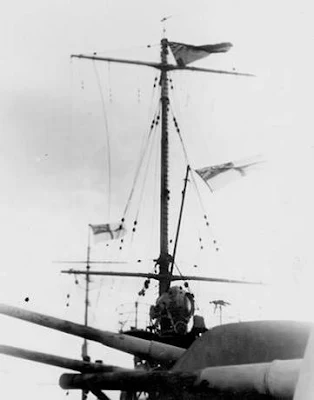A battle ensign is the name given to a large war flag which is flown on a warship's mast just before going into battle.
The flag identified the allegiance of the ship in what could be a very confusing situation, with thick clouds of gun smoke obscuring the ships in action, hence the large size of these ensigns typical for the Royal Navy from the 17th to 18th centuries of about 20 by 40 ft (6.1 by 12.2 m). It was commonly accepted that so long as a ship flew its ensign it was an active participant in battle; prior to action it was an acceptable ruse to fly a false flag.
If a ship surrendered then it would take down its ensigns (which was known as striking the colors). This is also the origin of the phrase "To nail one's colors to the mast", showing a determination to fight on and never surrender. In practice, warships would fly more than one battle ensign, so that if the flag was destroyed or brought down during the fighting there would be no confusion. Conversely, keeping the flag flying even though the ship might appear to be past fighting was a sign of determination rather than foolishness. The German battleship Bismarck continued to fly its battle ensign even after its gun batteries had all been silenced by British shells, and it sank with the ensign still up.
The battle ensign was seen as an important element for the morale of the crew and was held in high regard. If a warship was sinking and had to be abandoned, flags such as the battle ensigns would be taken off the ship before it sank and were entrusted to the senior (surviving) officer.
Some countries use their national flag as the battle ensign, while others use their naval ensign. Sometimes unique flags were made and used as battle ensigns, for example the one flown by United States Naval Forces at the Battle of Lake Erie in the War of 1812.
The battle ensign is sometimes also flown by U.S. Navy warships as a courtesy when entering or leaving foreign ports.
In the United States Navy, battle ensigns from American warships and battle ensigns captured from enemy ships are displayed at the United States Naval Academy at Annapolis, Maryland. The battle ensign flown from USS Arizona during the attack on Pearl Harbor by the Japanese Naval Air Forces on December 7, 1941 was badly stained with oil and it was burned as being 'unfit for further use', before anyone thought to save it.
From the start of the Naval Battle of Casablanca during Operation Torch, the USS Massachusetts flew an extra-large battle ensign in the hopes the French Forces would decide not to fight the U.S. Navy. The French decided to fight, and the Massachusetts continued to fly the large battle ensign, throughout the battle.
The USS Ramage uses the flag of the New York City Police Department as its battle ensign in commemoration of the actions of the NYPD during the September 11 attacks.
The British National Maritime Museum has in its collection a battle ensign taken from the Spanish San Ildefonso, captured at the Battle of Trafalgar which measures 9.8 by 14.4 m (32 by 47 ft).
An ensign from the French Généreux of 8.2 by 16 m (27 by 52 ft) was captured by HMS Foudroyant in 1800, and presented by its captain, one time Flag Captain of Lord Nelson, to the City of Norwich.
On 9 November 1914, HMAS Sydney wore a large Australian National Flag as a battle ensign from the mainmast during her celebrated victory over German warship SMS Emden at the Battle of Cocos. The battle was the first naval clash and first victory for the Royal Australian Navy.
In the early days of World War II Captain F. S. Bell of HMS Exeter gave the order to hoist battle ensigns as Exeter turned to engage German "pocket battleship" Admiral Graf Spee, which significantly outgunned her, during the Battle of the River Plate.
During the battle of the North Cape, after being ordered to close with and engage the German battleship Scharnhorst with torpedoes, Captain Skule Storheill of the Norwegian destroyer HNoMS Stord ordered the ship's battle ensign to be hoisted on the mainmast, so that "those bastards can see who they're dealing with!"
Battle ensigns were flown by nearly all British and Commonwealth ships, who had them available when about to go into surface action with enemy forces. The sole purpose was to ensure that an ensign would be left flying in the case of damage to the main mast or funnel gaff, where the ship's one flag was normally flown.
They were often larger than the standard size issued for the class of ship: e.g., if the normal ensign was 8 breadths—a breadth being 9 inches—battle ensigns would be 10 to 12 breadths, if available. When flown, they were flown from the foremast head or the foremast starboard yard. They were not normally flown in submarine actions, as there was little likelihood of damage to the upperworks.
In the cruiser action off the River Plate (Rio de la Plata) in December 1939, H.M.S. Exeter is reported to have flown four battle ensigns in all, just as well in view of the battle damage she sustained! In the second battle of Narvik, H.M.S. Warspite is shown in several paintings flying a very large battle ensign.
 |
| The 48-star battle ensign of the destroyer escort USS Samuel B. Roberts (DE-413). |
 |
| HMNZS Achilles battle ensigns. |
 |
| The White Ensign or the St George's Ensign, used by the Royal Navy. |
 |
| The Blue Ensign, used under Admiralty warrant by certain officers and clubs. |
 |
| A naval ensign of the Imperial Japanese Navy, November 1940. |


No comments:
Post a Comment